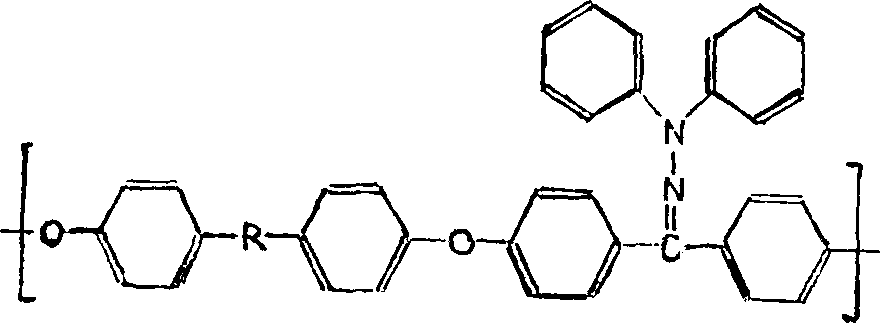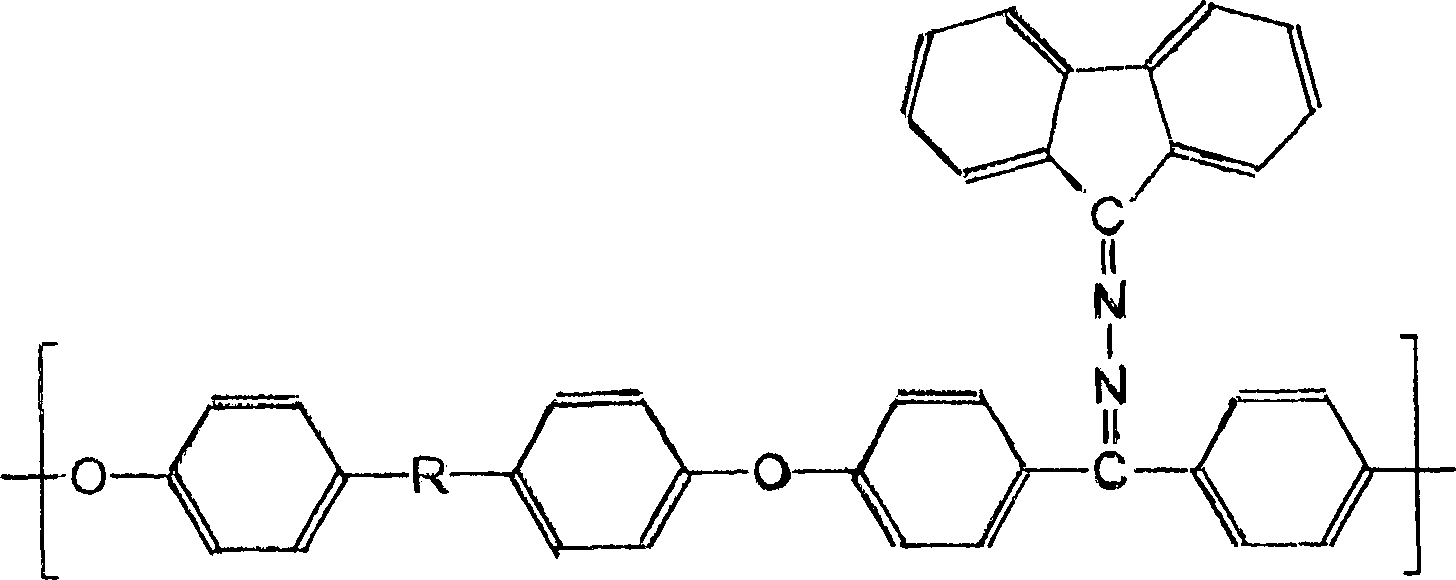Electrophotographic photoconductors comprising polyaryl ethers
A technology of polyaryl ether and photoconductor, which is applied in the field of improving the electrical characteristics of photoconductors, forming a charge transfer layer and a charge generation layer, and the field of charge transfer layers, which can solve the problems affecting the pot life of the composition and achieve improved Effect of pot life, good electrical characteristics, and long pot life
- Summary
- Abstract
- Description
- Claims
- Application Information
AI Technical Summary
Problems solved by technology
Method used
Image
Examples
Embodiment A
[0109] PAEK and PAES were synthesized by aromatic nucleophilic displacement reactions of difluorobenzophenones or difluorophenyl sulfones using various potassium bisphenolates. The reaction was carried out in N,N-dimethylacetamide solvent. Potassium bisphenolate is generally produced in situ by the reaction of bisphenol with potassium carbonate, and the water thus formed is removed by azeotropic distillation using toluene. In most cases, the reaction mixture became viscous after azeotropic removal of water and toluene and refluxing in dimethylacetamide solvent, which required about 2 hours.
[0110] All polymers were isolated by precipitation. Typical workup involves stirring the yellow-white fibrous polymer in water with a high-speed blender, neutralizing with aqueous acid (about 5% HCl), filtering, stirring in boiling water for 1 hour, filtering, and stirring in boiling methanol for about 0.5 hour , a step of filtering and drying in a vacuum oven at about 100° C. for about...
Embodiment B
[0150] Polyaryl ethers containing carbonyl or sulfonyl units are used for the preparation of dispersions of pigments such as Squirrel (HOSq) and type IV titanylphthalocyanine (TiOPc) in suitable solvents.
[0151] Preparation of Squirrel dispersion in a mixture (90 / 10 w / w) of tetrahydrofuran (THF) and cyclohexanone from HOSq pigments, PAEK including the above poly(bisphenol-A-benzophenone) (Polymer 1) body. The dispersion was stable for about 4-6 hours and eventually the phases separated. The dispersion was coated as a CG layer on an anodized aluminum drum followed by dip coating in a charge transfer solution. This HOSq / PAEK dispersion was compared to a standard control drum prepared by using polyvinyl butyral as the CG binder polymer. In a similar manner, a dispersion containing a blend of polyvinyl butyral (BX-55Z) and PAEK with HOSq was also prepared and compared to the above dip drum.
[0152] In contrast to PAEK dispersions without polyvinyl butyral, blends of polyviny...
Embodiment C
[0166] Several dispersions containing 45% TiOPc Type IV in a THF / cyclohexanone (90 / 10) mixture were prepared using BX-55Z, PAEK and polyvinyl butyral / PAEK blends. Table 7 summarizes the initial electrical properties obtained using photoconductors of these systems at an exposure-development time of 110 ms.
[0167] binder
[0168] V0.21μJ / cm 2 = at 0.21μJ / cm 2 Voltage; V0.42μJ / cm 2 = at 0.42μJ / cm 2 voltage
PUM
| Property | Measurement | Unit |
|---|---|---|
| thickness | aaaaa | aaaaa |
| thickness | aaaaa | aaaaa |
| thickness | aaaaa | aaaaa |
Abstract
Description
Claims
Application Information
 Login to View More
Login to View More - R&D
- Intellectual Property
- Life Sciences
- Materials
- Tech Scout
- Unparalleled Data Quality
- Higher Quality Content
- 60% Fewer Hallucinations
Browse by: Latest US Patents, China's latest patents, Technical Efficacy Thesaurus, Application Domain, Technology Topic, Popular Technical Reports.
© 2025 PatSnap. All rights reserved.Legal|Privacy policy|Modern Slavery Act Transparency Statement|Sitemap|About US| Contact US: help@patsnap.com


